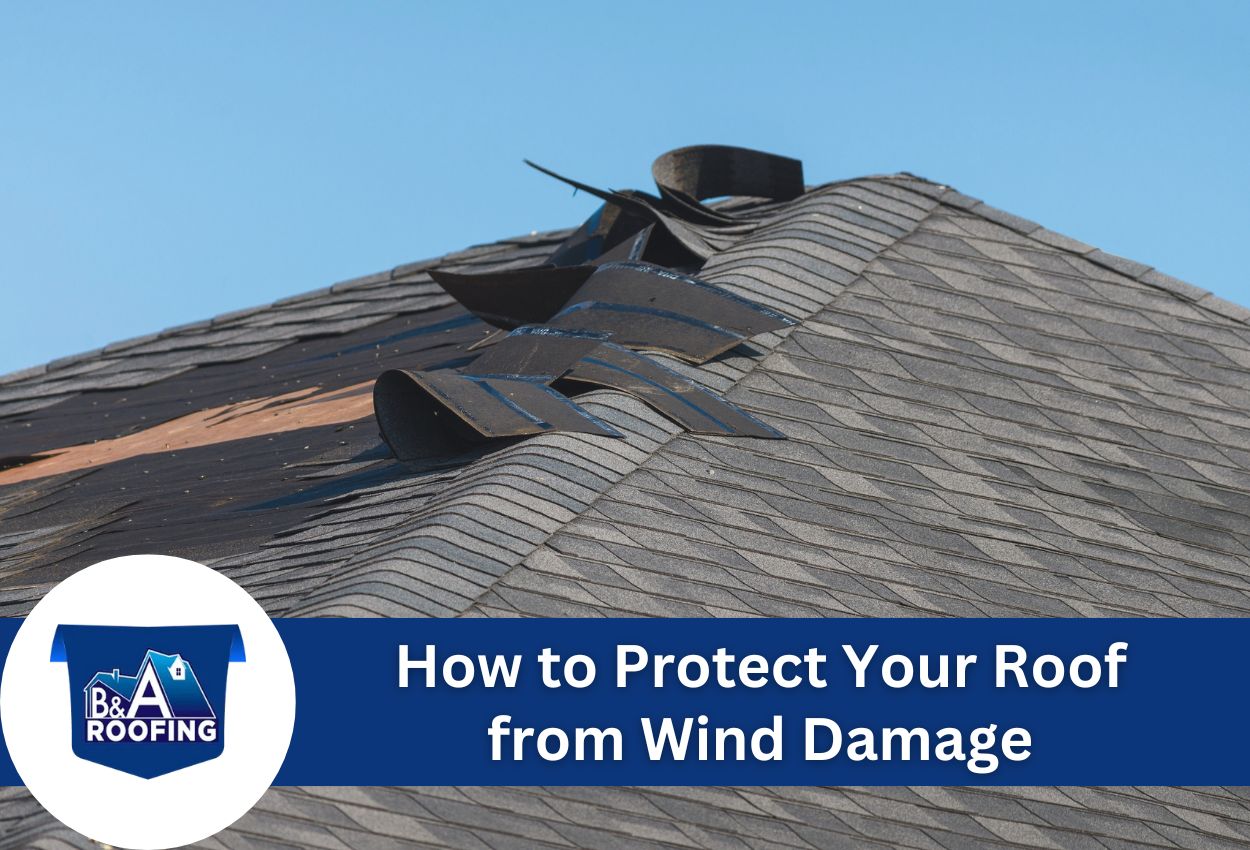For homeowners in Mississippi and Northern Alabama, protecting your roof from wind damage isn’t just a good idea — it’s essential. Our region experiences some of the most severe weather patterns in the country, with high winds, thunderstorms, and hurricane conditions that can compromise even well-built roofing systems. These powerful forces can lift shingles, damage flashing, and create vulnerabilities that lead to leaks and structural issues.
Wind damage to roofs often begins with small, seemingly insignificant problems that worsen over time. Loose shingles or tiles might not appear serious at first, but they create entry points for wind to get underneath and cause progressive failure during the next storm. Understanding how to protect your roof from wind damage involves knowing how to spot early warning signs and implementing preventative measures before severe weather strikes.
From securing roof shingles against high winds to implementing proven roof wind mitigation techniques, there are numerous strategies homeowners can adopt to strengthen their roofing systems. Whether you have asphalt shingles, a metal roof, or tile, extra protection methods can improve your roof’s resilience against our region’s challenging weather. By focusing on proper maintenance, strategic upgrades, and storm damage roof protection methods, you can extend your roof’s lifespan and avoid emergency repairs.
Understanding Wind Forces and Your Roof’s Vulnerabilities
Wind doesn’t just blow against your roof, it creates complex pressure patterns that attack your roofing system from multiple angles. When high winds sweep across Mississippi and Northern Alabama homes, they create uplift forces that essentially try to lift your roof off the house. This happens because wind accelerates as it moves over the curved surface of your roof, creating a pressure difference between the inside and outside of your home, similar to how airplane wings generate lift.
The most vulnerable areas of your roof include the edges, corners, and ridgelines, where wind forces concentrate with remarkable strength. Roof overhangs are the most susceptible, as wind can catch underneath them and create substantial upward pressure. In our southeastern climate, hip roofs typically perform better than gable roofs during high winds because they present less flat surface area for wind to push against.
Different roofing materials respond differently to these forces. Standard 3-tab shingles begin to fail at wind speeds of 60 to 70 mph, while architectural shingles might withstand gusts up to 110 mph when properly installed. Metal roofing systems are popular hurricane-proof roofing materials in our service area and can resist winds exceeding 140 mph when correctly secured. Understanding the vulnerabilities of each roofing material is the first step in implementing effective roof wind mitigation techniques and protecting your home during our region’s frequent storms.
Professional Roof Inspections: Your First Line of Defense
While DIY roof checks have their place, professional roof inspections remain the most reliable way to identify potential vulnerabilities before storm season. Homeowners should conduct basic visual assessments seasonally, looking for cracked, curled, or missing shingles, rusted flashing, and sagging areas. Watch for granules collecting in gutters, a sign of shingle deterioration that can weaken wind resistance. However, these self-inspections can’t replace the trained eye of a professional roofer.
Mississippi and Northern Alabama homeowners should schedule professional roof inspections at least once a year, if possible in the early spring before hurricane season begins. Professional roofers can spot subtle issues that are hard to see from the ground, including weakened adhesive seals between shingles, improperly driven nails, and deteriorating underlayment — all critical factors in wind damage prevention. They’ll also inspect roof-to-wall connections and ensure proper attic ventilation, which prevents pressure buildup during storms.
Addressing these weaknesses proactively improves your roof’s wind resistance. Something as simple as re-sealing loose shingles can prevent them from becoming “starter points” where wind can grab and peel back entire sections. Reinforcing roof-to-wall connections and ensuring proper fastener placement might seem minor, but these details often determine whether your roof survives over 80 mph winds. Professional inspections represent a small investment compared to the cost and disruption of major wind damage repairs.
Reinforcing Roof Components for Maximum Wind Resistance
When it comes to protecting your roof from wind damage, reinforcing the structural connections is absolutely critical. Hurricane straps, metal connectors that secure your roof trusses or rafters to the wall frames, provide significant reinforcement against the lifting forces that winds create. These relatively inexpensive hardware additions can increase your roof’s wind resistance by up to 50%, making them one of the most cost-effective roof wind mitigation techniques available to Mississippi and Northern Alabama homeowners.
Beyond basic hurricane straps, enhanced fastening systems using ring-shank nails provide superior holding power compared to standard smooth-shank nails. These specialized fasteners have circular ridges that grip the wood fibers, making them incredibly difficult to pull out even when subjected to powerful wind uplift forces. For existing roofs, a professional roofer can reinforce critical connection points during regular maintenance visits.
Securing vulnerable edges and transition points is equally important for storm damage roof protection. Ridge vents, while excellent for ventilation, create natural weak points unless properly reinforced. High-quality ridge caps with enhanced adhesive properties and additional fasteners can significantly strengthen these areas. Roof edges should incorporate properly installed drip edges, secured with fasteners spaced no more than 12 inches apart. These reinforcements at perimeter zones, where wind pressure is highest, create a continuous chain of strength that dramatically improves your roof’s ability to withstand our region’s severe weather.
Roofing Materials That Stand Up to Southern Storms
When it comes to protecting your home from the fierce winds common throughout Mississippi and Northern Alabama, choosing the right roofing material makes all the difference. Traditional 3-tab asphalt shingles, while less expensive, typically only withstand winds up to 60 to 70 mph, which is generally insufficient for our region’s severe weather patterns. Architectural shingles offer significantly improved performance, with wind ratings of 110 to 130 mph when properly installed, making them a solid middle-ground option for many homeowners.
Metal roofs have become increasingly popular in our storm-prone region, and with good reason. Quality metal roofing systems can withstand winds exceeding 140 mph and feature interlocking panels that eliminate the vulnerable edges found in shingled systems. Impact-resistant options provide additional protection against hail and flying debris. For maximum protection, consider standing seam metal roofs, which eliminate exposed fasteners that can fail during extreme weather events.
Recent technological advancements have produced impressive wind-resistant alternatives such as composite shingles that mimic the appearance of slate or wood while offering exceptional durability. Some manufacturers now produce hurricane-rated shingles featuring enhanced sealants and specialized nailing zones that improve wind resistance. For coastal properties facing the most extreme conditions, concrete tiles or slate roofs provide superior protection, though installation requires specialized expertise to ensure maximum wind resistance. The investment in premium materials pays off through reduced repair costs and greater peace of mind during storm season.
Landscape Management to Protect Your Roof
Smart landscape management plays a crucial role in protecting your roof from wind damage. Trees positioned too close to your home can become hazards during Mississippi and Northern Alabama’s frequent high winds. While trees provide shade and beauty, branches hanging over your roof can scrape against shingles during storms, wearing away protective granules. More seriously, falling limbs can puncture your roof, creating immediate leak points and compromising structural integrity.
To minimize these risks, maintain a safe distance between trees and your home — ideally at least 20 feet for large species. Regularly trim branches that extend over your roof, removing dead or weakened limbs before storm season arrives. Consider working with a certified arborist to evaluate the health of nearby trees and identify potential hazards that could threaten your roofing system during high winds.
Strategic landscaping can also create effective windbreaks that reduce wind force before it reaches your home. Dense evergreen shrubs and trees planted in staggered rows can significantly decrease wind velocity around your property. For maximum roof wind mitigation, position these windbreaks perpendicular to prevailing wind directions. Native species work best as they’re already adapted to local conditions and typically require less maintenance. This natural buffer not only protects your roof from wind damage but can improve your home’s energy efficiency by providing shade during summer.
Emergency Preparations: Before, During, and After the Storm
When severe weather threatens Mississippi and Northern Alabama homes, taking immediate action can mean the difference between minor repairs and catastrophic roof failure. If a storm is approaching, conduct a quick visual inspection of your roof from the ground, looking for loose shingles, unsecured vents, or damaged flashing that could worsen during high winds. Secure or remove outdoor items that could become projectiles, including patio furniture, grills, and potted plants.
For temporary reinforcement, consider using roof tarps secured with pressure-treated lumber for areas with existing vulnerabilities. Document your roof’s pre-storm condition by taking dated photographs from multiple angles — this evidence is often necessary for insurance claims. Ensure gutters and downspouts are clear of debris to prevent water backup that could exacerbate wind damage by adding weight to vulnerable edges.
After the storm passes, safety becomes the priority. Never climb onto a damaged roof yourself because structural integrity may be compromised even if damage appears minimal. Instead, use binoculars to conduct a preliminary assessment from ground level, looking for missing shingles, dented metal, or displaced roof elements. Cover any obvious openings with tarps to prevent water infiltration until professional help arrives. Contact a qualified roofing contractor immediately. Storm damage left unaddressed typically worsens with time, leading to interior water damage and mold issues that can significantly increase repair costs.
Protect Your Home from Wind Damage in Mississippi and Northern Alabama
If you’re concerned about protecting your roof from wind damage, don’t wait until it’s too late. B & A Roofing and Gutters specializes in reinforcing and repairing roofs to withstand the harsh winds common in Mississippi and Northern Alabama. Our experienced team can swiftly assess your roof’s vulnerabilities and implement effective storm damage roof protection methods to secure your home. Whether it’s upgrading your shingles, installing hurricane-proof materials, or applying advanced roof wind mitigation techniques, we’ve got you covered.
Don’t risk severe wind damage. Call B & A Roofing and Gutters today at (601) 520-3183 to schedule a professional inspection and ensure your roof is prepared for any storm.


